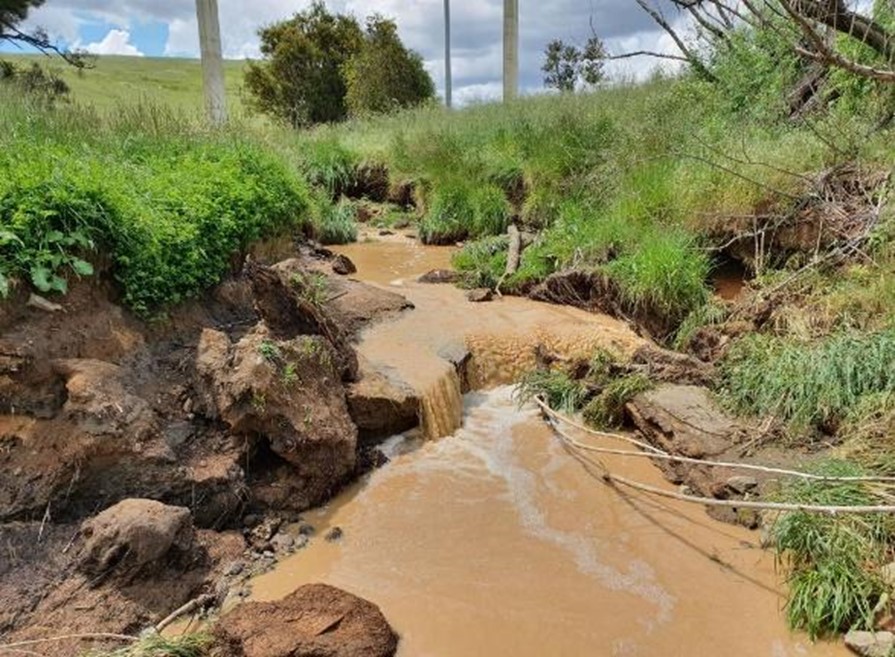Protecting our waterways from erosion and sediment
We're leading the charge to find new ways to protect Molonglo Valley waterways from erosion and sediment runoff during construction. The initiatives we put in place as part of this long-term project will help us protect waterways and environments across our future riverside developments.
Working closely with the Healthy Waterways Team and other colleagues, we’re drawing on cross-Government expertise to learn about better ways to control sediment and erosion.
The Whitlam Water Quality Project is trialling a number of different strategies, including next-practice sediment control measures, to ensure our waterways are better protected from large rain events that occur during construction. It’s inspired by approaches to controlling sediment runoff and erosion seen across Australia.
Next-practice is a commitment to a process of development, rather than an end product. It acknowledges that what is considered best is always changing. By continually building on past processes, we can keep improving our sediment and erosion control in the valley and create a new foundation for how we approach these processes in our future riverside developments.
High rainfall sparks action
The higher-than-average number of large rain events over 2020 and into 2021 created increased levels of erosion and sediment entering the Molonglo River from the catchment which includes Cook, Mount Paynter and Whitlam. Despite both our Whitlam construction sites conforming to the required Environmental Protection Agency (EPA) controls and all our work with EPSDD in responding to these matters, it became clear the current standards for sediment and erosion weren’t suitable for the steep topography of Whitlam.
One of our highest priorities is to proactively minimise our impact on the environment in the Molonglo Valley. Protecting water quality during construction and landscaping is an important element of our Sustainability Strategy and our new Sustainable Civil Construction Framework.
Tackling a complex challenge
Building in the Molonglo Valley presents a number of unique environmental challenges. It's currently home to some 13,000 residents across four suburbs and will eventually be home to an estimated 70,000 residents across a likely eight suburbs. Seven of these suburbs are directly adjacent to the Molonglo River Reserve, a location of natural beauty and high ecological value which reinforces the need for responsible stewardship.
Whitlam is close to the Molonglo River Reserve, which meant it has steep topography and several intersecting creeks. This posed a new set of challenges in the management of water during construction.
The following image shows the amount of sediment entering the Molonglo River Reserve before measures were in place.

A new approach
The Whitlam Water Quality Project sought to innovate how we control sediment and erosion at SLA, while always being open to new ways of working to reduce our impact.
By engaging an independent auditor to continually visit Whitlam and review how the controls in place are working, we’re constantly improving how sediment and erosion are managed in Whitlam.
Regular on-site check-ins have led to new resources, strategies and actions to ensure ‘next practice’ stormwater and sediment control measures reduce our impact on local environments and those downstream.
Regular audits of the Whitlam construction site are a key part of ensuring the Whitlam Water Quality Project can see continuous improvement and set the foundation for ongoing improvements in sediment and erosion control for our future developments.
The initial findings from the Whitlam Water Quality Project make 3 clear recommendations:
- The establishment of an inter-agency working group with key ACT Government Stakeholders, including ongoing consultation and collaboration during the design and construction phases.
- A program of engagement with an emphasis on key points in time where sediment and erosion control measures can be evaluated during design and construction.
- The engagement of an external expert to conduct an internal review of SLA sediment and erosion control practices where required.
Lessons learnt from Whitlam will be implemented during the construction of future suburbs in the Molonglo Valley and other SLA developments across the ACT.
Key methods for avoiding erosion
Check out some of the below images for approaches we’re taking to manage erosion and avoid sediment runoff during heavy rain events at Whitlam. These are just some of the ‘next practice’ solutions to sediment and erosion controls we’ll be taking into future SLA developments.
The following images show how turf, jute matting and coir logs are used in high-flow areas to quickly stabilise spillways and reduce scouring.